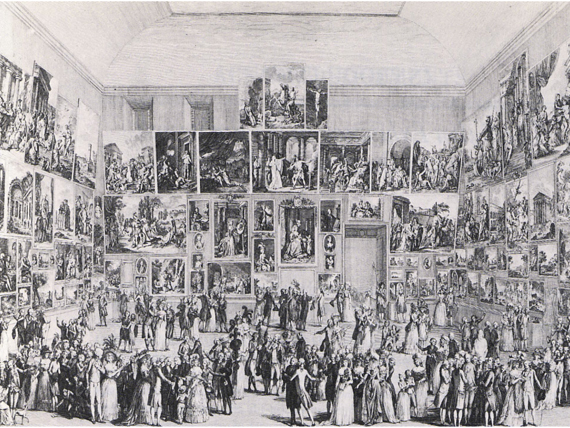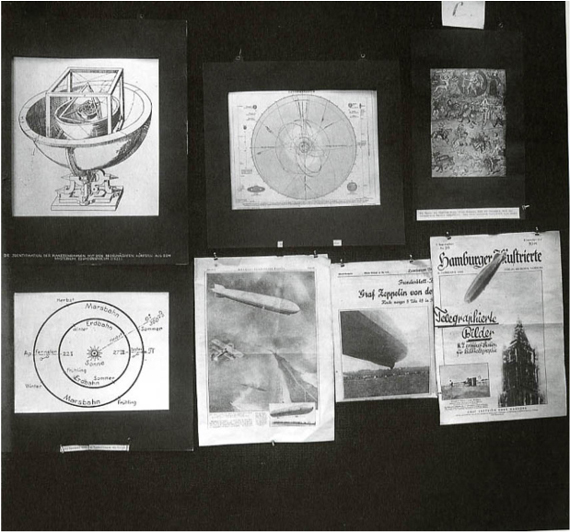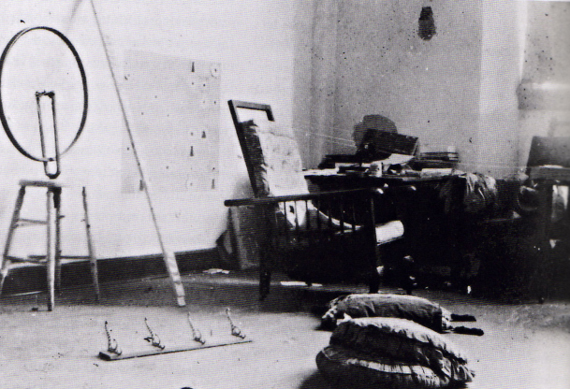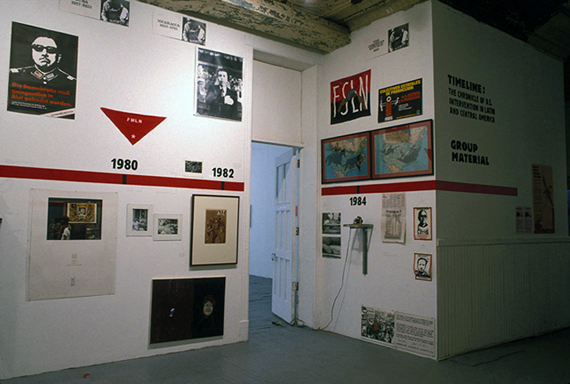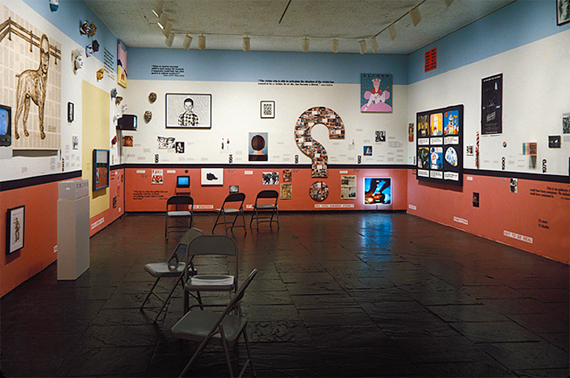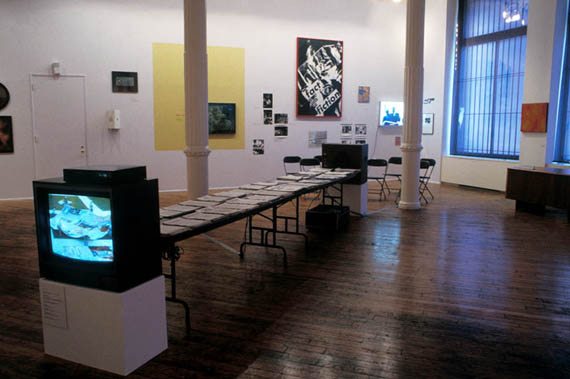09 2010
Group Material: Abstraction as the Onset of the Real
How do abstract understandings and images of the world become origins for democratic urgency? If anything was consistently true about Group Material’s practice it was our belief that the display of art is a political event; making a place where what it means to be a human subject is confirmed and debated.
Group Material
Democracy: Education. 1988
Dia Art Foundation, NYC
This presentation gives me the opportunity to address two recent concerns in my work: First is the problem of reconfiguring the arsenal that is the archive – as Julie Ault and I are this year preparing a public storage of all the GM material for the Fales Collection of New York University Library. Second is that my individual practice has been based for many years on the production of discrete and idealistically sovereign objects, a form of spectatorship seemingly at odds with the discursively motivated exhibition.
So what I want to talk about here today is the fallacious philosophical struggle between art-making as a sovereign and autonomous occupation based in affect and contemplation on the one hand – and art as an ethical pathway leading to social critique on the other. I can begin with the declaration that for Group Material, the proposition of this duality as an opposition is misunderstood when posed as a contradiction. Our effort was to see the friction between the emotions art produces and its proposal for political effect as creating an energy that propels multiple visions of humanity. When either formal or social directions for artistic evaluation are applied in a determinist way, puerile aesthetic disaster looms. The heavy trappings of the instrumental world of social causes result in artwork removed from speculation and association. Meanwhile the rigid adherence to formalisms artificially separated from their references to reality dry out the poetic relevance of dreams to action. Either limitation leaves us with basically the same dilemma: a status quo of decoration or dogmatism. And then we forget that epiphanic experience of both form and discourse present encounters with what we do not yet understand as human.
“I love my time.” When was the last time you heard this? Today artists are operating in a historical formation very different from the time of Group Material’s work. Although the planned economic disaster of neoliberal expansion seems to go on unabated, the capacity of the institutional inclusion of art paradoxically expands to include voices ever more critical of the political devastations of the day. Our time increases the defunding of social democracy and economic investment in cultural capital at the same time. While public life is officially impoverished, the social turn of art is embraced with significant institutional clout. This year New York was full of museums presenting exhibitions on “art and democracy”, relationalist practices, community based art and other previously disturbing traditions of blurring art with life. It is sadly interesting that in our time both economic privatization and cultural democracy can be subsumed under the same ethical banner. In this context I think it is important to ask: “Why now?” What is the use that social practices in art donate to the status quo in a time of political limitation? This is the question for us as artists, for our institutions and our audiences. My collaborator Felix always used to say that everything in culture happens for a reason – and I am curious why it is now that the relation between politics and art is so accepted, and in whose interests it is that we see the museum as more than a poetic depository, indeed as an ethical space, a space that can modify not only aesthetic decision but virtue itself.
The question of “Why now?” is particularly occupying at the archival point of Group Material’s work, because the investigation of social virtue in artistic invention was key to our initial project: by changing the social conditions for works of art, their effect on subjectivity could be rediscovered. And although I still believe this is a beautiful proposal, the nature of our times seems to demand some re-defending of its basis. Our effort was to directly engage with the critique of institutions through remaking the presentational context of existing art: a question about the genealogies of values that art creates when exhibited and promoted, a question of the curatorial and what it could create. But it was a question that came from art and artistic problems – from the formal, symbolic and vibrant rethinking of visual language. In other words, when we asked what could change if the exhibiting context for art was transformed into a forum of displacement and dialogue – we were demanding that art’s rediscovery of the self through strangeness and juxtaposition be applied to an entire room, a complete relation, a set of habits and traditions.
This question of “Why now?” is also affecting my thinking, because I have recently put some effort into trying to place the paradigms of dialogic art and politics into a broader discussion through the organization of actual conversations between producers of culture as way to site more independent conceptions of art production for myself and my students with a project called “Who Cares”, produced for Creative Time in 2006. In that project the failure of reconciliation between formal and political practitioners of public art stood out as an untenable reality for applying the generosity of art to politics.
But what I want to do here today is trace this question of today’s ethical turn in art through a history of Group Material’s work: first by examining my own sources for exhibition practices, then by going over the group’s Democracy Project in detail – produced in 1988 for the Dia Art Foundation, now Dia Center, by my myself, Julie Ault and Felix Gonzalez-Torres. If compared to contemporary work, this might help us reflect on the stunning changes taking place as ethics become enfolded into the way museums work. Such reflection is perhaps better represented here by more active participants in the social turn than myself – so I want to apologise in advance for any misconceptions on my part for mis-readings of the present.
Bernard le Bovier de Fontenelle
Conversations on the Plurality of Worlds. (frontispiece) 1683
The image we have been looking at so far in this talk is Bernard le Bovier de Fontenelle’s frontispiece to his seventeenth century book “Conversations on the Plurality of Worlds” – a book of fictitious conversations on the scientific discoveries of the time, their uses, their virtues. I want to present it as a kind of metaphor for the idea that our “social turn” here is both very old and very cosmological – or perhaps metaphysical. It was rendered for a 17th century book of the same title that proposed the human dialogue as an influence on the character of the universe: a proposal that our social interaction actually changes the nature of the world. I found the image recently when researching how it came to be that ideal, abstract understandings and images of the world could be thought of as part of the origin of modern democratic formation.
Group Material began because as artists we were desperate. We were desperate with the idea that our work would not be shown, or if it was, then it would be seen as only commodity. We were terrified that the complexities of our subjectivities would not be written in this world, and if they were they could not be understood. In this way Group Material was a collaboration of necessity, of money and a rented space in the tradition of making space – a room of ones own, a gallery.
We thought the true complexity of artistic experience was overlooked by both the narrow scholarship of existing museum studies and the commodified taste culture within the existing framework of art reception. We thought this dual degradation on the social effect of art could be countered with a designed intervention using an ensemble of activities brought together collaboratively by artists and new audiences. This was not our invention. We found it in the art-making that came before us in Courbet, Mayakovsky, Clifford Still and James Brown, Wallace Stevens and Paolo Friere, Michael Asher and Charles and Ray Eames.
And there were other art historical experiences that were in my mind at that time – and still are:
Pietro Antonio Martini
The Paris Salon of 1787. (engraving)
First is that the private reveries of experience produced by the wonder cabinet were not lost when it was confronted by the public site of art collecting – the salon – the anti-salon and so on. I would insist that as artists, even as humans, our dreams follow us into work as we move from the bedroom, to the studio and into democratic forums and back again. The idea that a visual experience can produce a meeting with an unknown is consistent with all the places we occupy. Did you see the thing that I just saw? What I show here are images of the progression of the public display of from Wunderkammer to the salons of post-revolutionary Paris, but the idea that the energy of wonder meets us in public and private at the same time is still a kind of mystery.
Aby Warburg
Memory Atlas. 1929
Secondly I want to understand the associative modernist historicisms that these images present: Andre Malreaux’s “Imaginary Museum” and Aby Warburg’s “Memory Atlas” are both in my mind creative mappings that make available to us autonomous misrecognitions of existing protocol. I use that word knowing it has a negative etymological shadow, and it is my invention, if you will allow me, to put it forward here as a term of generosity: seeing the categories of meaning that exist in a different or inherently “wrong” fashion. I use it to imply that in every accepted trajectory for the collection and distribution of art there are possible events of resistance – ways to read and make differently that could upset the functionalist appropriation of art by dominating economies of thought and exchange.
Burnett, R.Will
Zoology, The Golden Guide. (illustration)
To make another example of the possible generosity of misrecognition, I would like us to think of the tradition of natural history taxonomy as a cascade of fiction. What if the categorization of what is defined as human was broken and expanded? In a sense, disruption is always inscribed into the original categories of research. Even Linneaus, with his implied tree of animal categories pictured here, had to admit that one could not take in all the differences and similarities that nature presents at once. It is more than we can ever diagram.
Such a disruption inherent in art demands we drift or fall – collapse existing definitions and subjectivities in order to reinvent who we are and what our “nature” is. To include disruption into a plan demands we retain the capacity to accept the collapse of that plan’s expectation and dismantle existing definitions and subjects to engage life independently from existing rhetorical organization. Can the definition of the human be dismantled through artistic labor into a different kind of operation, determined either in secret or in public as collaboration? I would like to see the social in art as suggesting bathos based on an aesthetic of falling, surrender and confusion – exemplified here in the image of this magical artwork titled “Trebuchet”. It is the trap forcing a visitor to loose control, to fall after walking a few steps into Marcel DuChamp’s studio.
Marcel DuChamp
Trebuchet (Trap).
Photo by Henri Pierre Roche, c.1916-1918
I would like to posit these historical examples as possible senses, gleaned from the past and added to the contemporary understanding of Group Material’s work. I am now going to run through a short history of our projects as a way of introducing the larger issue of how social practice in museums has changed.
Group Material
The People’s Choice (Arroz con Mango). 1981
Group Material began as a tool for doubled collaboration – a collective of artists itself and a collecting agent for artistic examples at the same time. One misunderstanding of Group Material’s work is that it was based on movement politics. I think this is a misconception. I don’t remember a time when we were working to empower others – but we did have an idea of inclusive antagonism in all our interactions. This show, People’s Choice was produced with the idea that the objects culled from our friends and neighbors would produce an alternative archive of the experiences of art, an experience deduced from the beliefs of others – those not in the room. How are we today concerned with the notion of an encounter with working procedures that are not present, unseen?
Group Material
Timeline: A Chronicle of US Intervention in Central and South America. 1984
PS1, NYC.
GM saw the museum as a site of already existing social influence; a politics in itself and also of others. The reductive notion of institutions determining subjection the way an engineer determines mechanical forms was clearly not useful. We wanted to address new audiences with concrete political descriptions – but with a form that would undermine accepted artistic and activist positions alike. This Timeline of US Interventions in Central America chronicled the 88 physical military interventions in Central and South America by the US military between 1893 and 1984, the year of this show. But the show was also an essay on the misrecognition of art with time – with a Diego Rivera still life corresponding to the present and a John Heartfield to the 19th century. To misrecognize history itself was an integral part of our insistence on remaking artistic values. Timeline was produced for a larger collective effort produced in NY and across the country – Artists Call Against US Intervention in Central America – where artists inspired about 30 galleries and museum exhibitions in NY, most of the art magazines, and many street events – all together raising close to 140,000$ which was sent to the cultural arm of the Sandanistas, the FMLN and solidarity groups in the US.
Group Material
Subculture. (advertisements on the IRT Subway Trains)
NYC, 1983
The public spaces of the City then were no more and no less a site for collective re-imagination than the gallery. However, it is true that publicity culture in 1984 may have seemed more open to reinvention emptied of the hierarchical expectations that accompany contained archives and collections. In this project Group Material was more a subcontractor than a designer of artistic groupings. Subculture was 2700 placards produced by 100 artists periodically filling the spaces built for advertising on the IRT subway line. Although there were many detournements of commercial languages produced for this project, one notable case was the presence of an actual painting of a woman running out of a burning house – seeing this in the place of a printed ad was radical enough a displacement to cause disturbance.
Group Material
DA ZI BAOS. 1982
Union Square, NYC
We saw the street and the museum as potential sites of invigorated dialogue on the nature of the appropriate place for epiphany and action, places where disensus and conflict could be planned, and clashes between public and private could be refigured. The poster project Dazibaos was modeled after the large character poster that went up during the Democracy Wall movement in China – the landscape of social reflection in which contestation can be seen as a basis of democracy.
We tried to understand this invigorated dialogue as taking place in regarding art objects themselves, in the feelings of de-centeredness in delegating objects as having power or an aura, from which comes the dialogue of appreciation of that power and its social implications. From poetics comes conversation and then collective decentering and the search for resolution forms poetics.
To this end artifact and art were hung together, archive and collection were dispersed, the line of the commercial gallery was overcome by the salon, and could become an emotional enactment of the ensemble of feelings inherent in political work.
Group Material
AIDS Timeline (New York City:1991)
Whitney Bienial, 1991
AIDS Timeline is perhaps our most fluid example of this, a case where a newspaper and morbidity report, an AIDS profiteer sticker and a non-objective painting were all hung together. To combine the editorial and the emotive was our purpose, the comparison budgets for B2 bombers with the lyrics of “It’s Raining Men” a possibility of resistance found in abstraction, in the emotional connection to a history we are experiencing as it happens. We tried to think the aesthetic and the political together, formed within the context of art and its possible world of proposition and response and proposition – a multiplication of possibilities.
Group Material
Democracy: Education. 1988
Dia Art Foundation, NYC
Hopefully it is evident through these examples that as Group Material’s work matured, it became more and more clear that in order to oppose the oblivion of the present, a form had to be invented: a visualization of democratic process. How else could an authentic response to the imposed disaster of contemporary life be seen? As artists we knew that in the street and the symposia forms of response were often beautiful – that collectively diverse declarations of the democratic have all the qualities of improvisation, comparison, proportion, absence, and substitution. Despite the plethora of critical tracts produced during this time on the politics of space, the practices that Group Material developed were barely theorized, but were instead suggested by the callings of the daily matter of life over death: be it the formation of Central American independence movements facing American sponsored genocide or the activist response to official indifference to the AIDS epidemic. In other words, the form of our art-making was produced through affinity with the forms of political work we ourselves were invested in: as laborers, as labor organizers, as public teachers, as friends. Our forms of exhibition and public practice reflected the need to invent a dynamic situation, a designed moment of reflection that could include discussion and present dissent.
In 1987, The Dia Art Foundation, now the Dia Center, was under a kind of reorganization and sought, not unselfishly perhaps, to find a generative year of exhibitions to coincide with its new management. To that end they invited Group Material take over their Wooster St Space and produce work for half a year.
Group Material
Democracy: AIDS and Democracy: A Case Study. 1988
Dia Art Foundation, NYC
The Democracy Project itself was really a quartet of practices: private meetings, exhibitions, public assemblies and then a book collecting together records of our organizational events with a series of texts that informed them. Democracy was our theme, because it was already our form, the exhibition unanchored from the equation of thesis and promotion. Our adopted form is an analogy of the empty room, physically turned over to a stutter of inclusion, to dissensus and contestation: a site of constantly changing representation of human will, however uncertain and unrecognized. Foregrounding uncertainty was linked for me to other aesthetic histories, even theological histories, of re-positioning the possibility of virtue into another person or thing that is unknown. Perhaps then aesthetic knowledge can be the beginning of the de-centering of self proposed by social movements for emancipation in facing shared alienation. Perhaps this is part of the political nature of the emotional realignments we might experience and share around the work of art – not, I suppose, a very new idea.
For the Democracy Project our first thought was to do away with the idea of singular curatorial selection altogether, to throw away the object list, go beyond metaphor and instead directly engage an audience that would actually move objects in and out of the gallery in response to the political reality of the day, the week or month: an exhibition that would change with the people who came to see it. It quickly became clear that such liberalizations were unlikely when faced with actually lifting a Joseph Beuys blackboard piece in and out of the showroom.
Group Material
Democracy: Education. 1988
Dia Art Foundation, NYC
So instead we decided to treat democracy essayistically – through the outline of four related thematic experiences that would trace three of America’s great abstract promises and America’s failures in democracy and ending with one exhibit as case study – on the most cogent failure we were living through at the time: the creation of the AIDS crisis due to governmental, media and medical indifference. Four basic failures of American democracy were chosen: Education; Politics and the Election, Cultural Participation and AIDS, a case study. These four shows were hung in rapid sequence over about six months, mirroring the timing of a commercial gallery. Each had a different set of organizing visual principles. But there were quiet consistencies like a variation on the American flag hanging throughout. Each had different constituencies, imagined and explicit, – for example AIDS a case study reflected the working activism of ACT-UP; Education included the organizations of teacher activists and unions. And each had visual principles applied to their design that could evoke resonance in their shared perception and moods. For example we had a raffle for Cultural Participation and a ceiling full of red, white and blue balloons for the opening of Politics and the Election. But more important for my argument here is the fact that we built contexts of social investment from others, we organized from the beginning a larger identity of authorship through invitation and associations – to prove that all aesthetic forms are produced along with larger social relations, which are both lived in our work and are imagined in identifying with things past.
Roundtable Discussion for
Democracy: Cultural Participation. 1988
Photo: Dia Art Foundation, NYC
We organized this social platform in three ways:
First of all, for each show we organized a roundtable discussion that preceded the exhibition and informed us for larger collaborations involved in finding objects to display and enlarged the agendas for our audiences. These meetings were attended by both artists and non-
Secondly and in a less direct manner – but perhaps more crucial to the actual form of the shows – we sought out and invited constituencies and individuals – not all necessarily artists, to actually contribute work to be exhibited. These “communities of concern” produced the real dynamism of the exhibition, creating viewing experiences that had to traverse Joseph Beuys, the children of public schools in east New York, the photos of Lewis Hine and community graphics.
Flyer for Town meeting
Democracy: Education. 1988
Dia Art Foundation, NYC
Lastly, for each we produced a town-meeting type assembly, which coincided with both the topic and time period of each exhibition, arranging a large public platform for public discussion. The original notion of our Town Meetings was to undo the notion of expertise, to replace the singularity of the proscenium with the multiplicity of the audience: to focus on inclusion so as to not mirror oppressive structures. As has been pointed to by others, this exalted notion of organized dialogue is often only an emulation of participation – a mere mediagenic image of inclusiveness. But our original intention was to allude to the prototypical democratic experience and to try to dissolve the demarcation between experts and initiates – anyone in the audience was a potential speaker. Much of the discussion built upon issues raised in the roundtable meetings and the exhibitions, but overall each was very different due to changes in moderators and attendance. The content was delivered by whoever attended.
Cover, Democracy: A Project by Group Material.
Wallis, Brian. ed. Bay Pres, Seattle 1991
After the roundtables, exhibitions and town-meetings we produced this publication, bringing together a variety of voices and points of view to addresses the issues in American democracy and provide possible means for responding to its challenges. The book was meant to address an audience far wider than could actually attend the events – and I have to say it has, particularly in the area of public education, a field I spend most of my energy on these days. I am repeatedly rewarded by interactions with teachers and community organizers who have seen this document as a menu of possibilities for education to continue its Jeffersonian mandate of breaking down the barriers proposed by race, class and territory in America.
Over all, our efforts in the Democracy project were to try to see how democracy happens at the site of representation itself, not just where information is transferred or built, but rather at the very place we recognize ourselves in performing images, where we have the sense we that we are ourselves, feel a stability that is hailed and recognized by others. A radical representational moment, whether collective or not, is one that suggests we can give ourselves over to a new vision through feeling, an experience linked to contemplation and epiphany. In this way no public description of another, in frame or in detail, can be presented as politically neutral. So when Group Material asked, “How is culture made and who is it for?”, we were asking for something greater than simply a larger piece of the art world’s real estate. We were asking for the relationships to change between those who depict the world and those who consume it, and demonstrating that the context for this change would question more than just the museum: a contestation of all contexts for public life. In making exhibitions and public projects that sought to transform the instrumentality of representational politics, invoking questions about democracy itself, Group Material presented a belief that art directly builds who we are – it engenders us.
As I’ve already said, Group Material’s methodology of cultural displacement was anchored in a strong yet abstract image of the process of political work. This abstract image of democracy as a void means that social assembly could be visually positioned as a struggle that never ends. It is a template of a social forum that rejects the consensus of pluralism and replaces it with a radical abstraction of temporary agonism – an assignment of discussion’s unpredictability and inclusion into an imaginable shape – a shape that is always irregular and fluctuating: an abstract matrix for the real.
Group Material
Democracy: AIDS and Democracy: A Case Study. 1988
Dia Art Foundation, NYC
Art presented as a changeable social forum, as dialogue, presents a context where not just images but political mutuality itself can be personified – a collection of the various positions and possible volitions of different people. Encountering this complexity in the form of art is equivalent to viewing a variety of bodies’ positions, looking through another’s eyes across this vista toward this or that city or even inwards. It may be a Renaissance cliche that I can occupy the eyeballs of another through a position proposed in a work of art, that through this transubstantiation I am in an encounter with someone unknown. The formal and physical presence of another is difficult to discuss rationally, because the sense of the point of view of another person is so much more than the strict diagramming of corporeal perspective, the agreement or disagreement with a position.
Accordingly we believed that the existing management of art, and of culture in general through the market, enforces a complex system of limiting notions of what makes “us” us or “me” me, what normalizes and enacts the contours of fixed identity. The definitions of gender, race and power were, and still are, dependent on a visual system – images that make possible the recognition or misrecognition of ourselves, between ourselves.
Myron Stout
Untitled, 1950 (May 20)
oil on board
I want to end with this image of a painting by Myron Stout painted about 40 years before Group Material’s Democracy show.It has no title – for me it is a visual experience that is directly representative of the possibility of visual access to social reimagination. I would like to give a lecture like this someday to this painting, directly facing it – with the audience facing it along with me.
Last month the social historian Robert Hulot Kentor gave a lecture in my class on the barbaric nature we all become through the technologies and bureaucracies of separation and specialization that have been incorporated into every day life. As a response, a colleague sent me this poem to be read to my students the following week.
This is
“The road Home” Wallace Stevens
It was when I said,
“There is no such thing as the truth,”
That the grapes seemed fatter.
The fox ran out of his hole.
You. . . You said,
“There are many truths,
But they are not parts of a truth.”
Then the tree, at night, began to change,
Smoking through green and smoking blue.
We were two figures in a wood.
We said we stood alone.
It was when I said,
“Words are not forms of a single word.
In the sum of the parts, there are only the parts. The world must be measured by eye”;
It was when you said,
“The idols have seen lots of poverty,
Snakes and gold and lice,
But not the truth”;
It was at that time, that the silence was largest
And longest, the night was roundest,
The fragments of the autumn warmest,
Closest and strongest.
This essay is a rewritten version of a paper given for the "New Productivisms" conference at Museu d'Art Contemporani de Barcelona in 2009.




